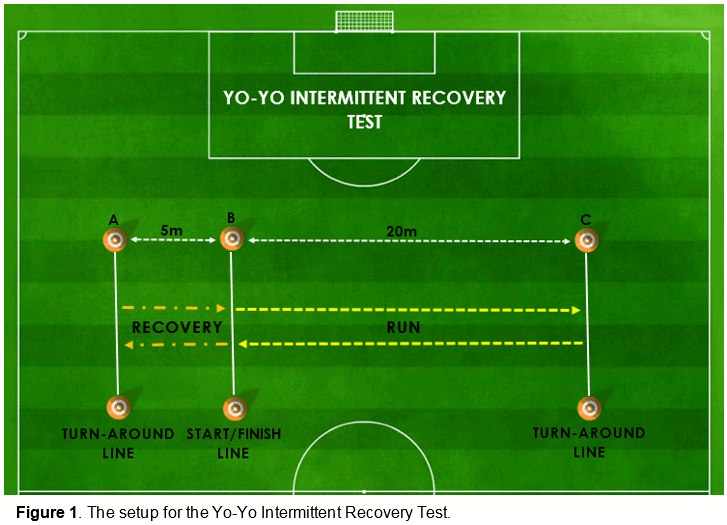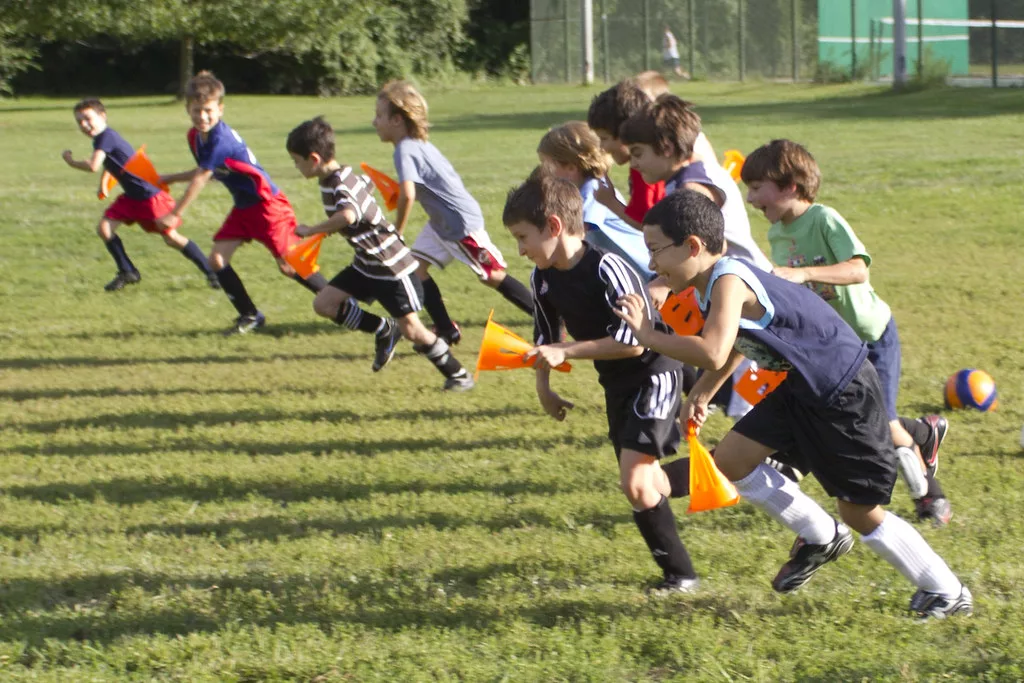Contents of Article
- Summary
- What is the Yo-Yo Intermittent Recovery Test?
- How do you conduct the Yo-Yo Intermittent Recovery Test?
- Considerations for the Yo-Yo Intermittent Recovery Test
- Is the Yo-Yo Intermittent Recovery Test valid and reliable?
- Are there any issues with the Yo-Yo Intermittent Recovery Tests?
- References
- About the Author
Summary
The Yo-Yo Intermittent Recovery Test Level 1 test was developed to measure an athlete’s ability to repeatedly perform high-intensity aerobic work. Since then, it has been established as one of the most commonly used aerobic field tests for youth and recreational athletes. It has been shown to be a valid and reliable predictor of high-intensity aerobic capacity and VO2 max amongst athletes from various sports and competition levels.
What is the Yo-Yo Intermittent Recovery Test?
There are three variations of the yo-yo intermittent recovery test: level 1, level 2 and the submaximal test. The yo-yo intermittent recovery level 1 (YYIR1) focuses on an individual’s ability to repeatedly perform high-intensity aerobic work. The yo-yo intermittent recovery level 2 (YYIR2) test examines the capacity to perform intense intermittent exercise with a large anaerobic component in combination with a significant aerobic contribution. The submaximal yo-yo intermittent recovery test was developed as a method of monitoring performance during competitive periods (e.g. in-season), injury rehabilitation, or individuals who may struggle with performing the maximal tests (1).
The YYIR tests are a simple method for examining an athlete’s capacity to perform repetitive high-intensity aerobic exercise (2). The YYIR1 is designed for young or recreational athletes who possess lower aerobic capacity – this level begins at 10km/hr. The YYIR2, on the other hand, is designed for elite and professional athletes with a higher fitness capacity – this test begins at 13km/hr. Therefore, the only difference between these two tests is the speed at which they are conducted (1).
It has been demonstrated in sports involving high-intensity intermittent exercise that the higher the competition level of the athlete, the better their performance on the YYIR tests (2). Performances in the YYIR tests for young athletes have also been shown to improve with increases in age (3, 4, 5, 6). However, this may be more specifically related to biological maturity rather than chronological age.
Regardless, YYIR tests have also been demonstrated to be a more sensitive measure of performance changes than maximum oxygen uptake (VO2 max). Furthermore, as relationships between sub-maximal YYIR test performance and heart rate have been observed, non-exhaustive versions of these tests can be used during competitive periods (in-season), with older subjects, and athletes recovering from injury (2).
How do you conduct the Yo-Yo Intermittent Recovery Test?
It is important to note that whenever fitness testing is performed, it must be done so in a consistent environment (i.e. facility) so it is protected from varying weather types, and with a dependable surface that is not affected by wet or slippery conditions. If the environment is not consistent, the reliability of repeated tests at later dates can be substantially hindered and result in worthless data.
Required equipment
- Facility – Consistent, flat and non-slip (minimum length of 30m)
- Marking cones
- Measuring tape (>30m)
- YYIR test audio CD or MP3
- CD or MP3 player with loudspeaker (volume of speaker is particularly important)
- Performance recording sheet
- Officiator who records the number of shuttles completed (explained in the ‘Scoring’ section).
Test Configuration
Figure 1 displays the configuration for the YYIR tests, which must be adhered to if accurate and reliable data is desired.

Procedure
Once the test configuration has been set up, the test officials are positioned at both shuttle lines (cones B and C) and participants are ready, then the test can begin.
Test Procedure
- Participants begin the test from cone B.
- When instructed by the audio player, they must run towards cone C (this must be reached before the following beep signal) and immediately return to cone B before the next signal.
- Once cone B is reached, participants then have a 10-second recovery period in which they must jog from cone B towards cone A, and then back to cone B before the commencement of the next shuttle.
- In this test, the participants are only allowed two consecutive fail attempts before they are withdrawn from the test. That being, if the individual fails to reach cone C and back to cone B in the allocated time, one fail is issued. If this happens a second consecutive time, then they are eliminated.
- Once withdrawn from the test, the individual’s score must be recorded.
- The YYIR1 typically last for 5-15 minutes, and the YYIR2 for roughly 2-15 minutes (2, 7).
Scoring System
The test is comprised of 91 shuttles and can last up to approximately 29 minutes; however, it is very unlikely somebody will complete it. Scores can be presented in three ways: 1) total distance (meters); 2) level achieved; or 3) VO2 max. Total distance is much simpler to understand and calculate, whereas the level achieved is more complex, as the test begins at level 5 and then skips to level 9 at the beginning.
How to calculate Total Distance
This is the simplest, most common, and perhaps the most reliable method of reporting YYIR test performance.
To calculate total distance, the simplest method is to record the number of shuttles completed by the participant and then multiply that number by 40 (40 = 2 x 20 m shuttles [the run from cone B to cone C = 20 m, then run back from cone C to cone B = 20 m]).
For example, if an athlete performs 30 shuttles, this number can then be multiplied by 40 to calculate their total distance (e.g. 30 x 40 = 1,200 m)
How to calculate Level Achieved
To calculate level achieved, click the link below. The image is very large, so make sure you zoom in to see it correctly.
http://www.5-a-side.com/wp-content/uploads/2014/03/Yo-yo-intermittent-recovery-test-levels.jpg
How to calculate VO2max
Though the YYIR1 has been shown to be a moderately reliable predictor of VO2 max (8, 9), it is advised to use the test for what it was originally developed for – identifying an individual’s ability to repeatedly perform high-intensity aerobic work, which has proven to be a more sensitive measure of changes in performance than VO2 max. Regardless, for those who wish to use this method, the equations for calculating VO2 max are below:
- YYIR1 test: VO2 max (mL * kg-1 * min-1) = IR1 distance (m) × 0.0084 + 36.4
- YYIR2 test: VO2 max (mL * kg-1 * min-1) = IR2 distance (m) × 0.0136 + 45.3
Considerations for the Yo-Yo Intermittent Recovery Test
When conducting the test there are several factors that need to be taken into consideration before you begin. Some of these include:
- Individual effort – Sub-maximal efforts will result in inaccurate scores.
- Test regulation – It is vital to have at least two coaches officiate the procedure to prevent any test misconduct, such as not reaching the end-line before the beep.
- Clothing and footwear – incorrect clothing and/or footwear could easily lead to sub-maximal efforts and therefore worthless data.
Is the Yo-Yo Intermittent Recovery Test valid and reliable?
It is critical the coach understands the test is both valid and reliable before they include it within their testing battery. Any test that lacks significant validity and/or reliability will produce worthless results that should not be used literally. Moreover, even a test with sufficient validity and reliability will still have some degree of error/inconsistency, but understanding how much is a crucial part of the data analysis.
The YYIR1 has been repeatedly proven as a valid and reliable tool with high reproducibility for measuring high-intensity aerobic capacity amongst athletes from various sports and competition levels (10, 11, 12, 13). Furthermore, the YYIR1 has also been shown to be a moderately reliable predictor of maximal oxygen uptake (VO2 max) (8, 9).
Are there any issues with the Yo-Yo Intermittent Recovery Tests?
Whilst the test itself is reliable when performed correctly, it is however subject to several weaknesses.
- Regulating the test with large groups becomes somewhat difficult, as it is hard to track which athletes have repeatedly failed to reach the end-line before the beep. Therefore, it is strongly advised that multiple assessors officiate the test.
- It is shown that test familiarity can impact results, meaning individuals who are unfamiliar with the test procedure may achieve less than optimal scores. Consequently, test familiarisation is highly recommended.
- Fanchini, M., Castagna, C., Coutts, A.J., Schena, F., McCall, A., & Impellizzeri, F.M. (2014). Are the Yo-Yo intermittent recovery test levels 1 and 2 both useful? Reliability, responsiveness and interchangeability in young soccer players, Journal of Sports Sciences, 32(20), pp.1950-1957. [PubMed]
- Bangsbo J, Iaia FM, Krustrup P. The yo-yo intermittent recovery test: A useful tool in evaluation of physical performance in intermittent sports. Sports Med 2008;38:37-51. [PubMed]
- Mohr M, Krustrup P, Bangsbo J. Match performance of high- the preseason and the first part of the in-season in professional standard soccer players with special reference to development football league players in Japan [abstract]. In: Aagaard P, of fatigue. J Sport Sci 2003 Jul; 21 (7): 519-28. [PubMed]
- Krustrup P, Mohr M, Amstrup T, et al. The Yo-Yo intermittent recovery test: physiological response, reliability and validity. Med Sci Sports Exerc 2003 Apr; 35 (4): 697-705. [PubMed]
- Barbero Alvarez JC, Barbero Alvarez V. Efectos del enTeam Denmark and the Ministry of Culture, Denmark. The trenamieno durante una pretemporada en la potencia maxima authors have no conflicts of interest that are directly relevant aerobica medida dos test de campo progresivos, uno continuo y to the content of this review. otro intermitente. Granada: Departamento de Educacion Fisica Y Deportiva, Facultad de Educacion y Humanidades de Melilla, Universidad de Granada [online]. Available from URL: http://www.futbolrendimiento.com.ar/Download/ References Pretemporada %20y%20PMA%20en%20futsal.pdf [Accessed 2007 Nov 15].
- Garrett, W.E. Jr., & Kirkendall DT. Physiology of soccer. In: Garrett. DT, editors. Exercise and sport science. Philadelphia (PA): Lippincott, Williams & Wilkins, 2000: 875-84. [Link]
- Krustrup, P., M. Mohr, L. Nybo, J. Majgaard Jensen, J. Jung Nielsen, and J. Bangsbo. The Yo-Yo IR2 Test: Physiological Response, Reliability, and Application to Elite Soccer. Med. Sci. Sports Exerc., Vol. 38, No. 9, pp. 1666–1673, 2006. [PubMed]
- Karakoç, B., Akalan, C., Alemdaroğlu, U., & Arslan, E. (2012). The Relationship Between the Yo-Yo Tests, Anaerobic Performance and Aerobic Performance in Young Soccer Players. Journal of Human Kinetics, 35, 81–88. [PubMed]
- Thomas, A., Dawson, B., & Goodman, C. (2006). The yo-yo test: reliability and association with a 20-m shuttle run and VO2 max. International Journal of Sports Physiology and Performance. 1(2), pp.137-49. [PubMed]
- Krustrup P, Mohr M, Amstrup T, Rysgaard T, Johansen J, Steensberg A, Pedersen PK, Bangsbo J. The Yo-Yo Intermittent Recovery Test: Physiological response, reliability and validity. Med Sci Sports Exerc 2003;35:697-705. [PubMed]
- Deprez D, Coutts A, Lenoir M, Fransen J, Pion J, Philippaerts RM, Vaeyens R. Reliability and validity of the Yo-Yo intermittent recovery test level 1 in young soccer players. J Sports Sci 2014;32:903-910. [PubMed]
- Castagna C, Abt G, D’Ottavio S. Competitive-level differences in yo-yo intermittent recovery and twelve minute run test performance in soccer referees. J Strength Cond Res 2005;19:805-809.[PubMed]
- Souhail H, Castagna C, Mohamed HY, Younes H, Chamari K Direct validity of the yo-yo intermittent recovery test in young team handball players. J Strength Cond Res 2010;24:465-470. [PubMed]




